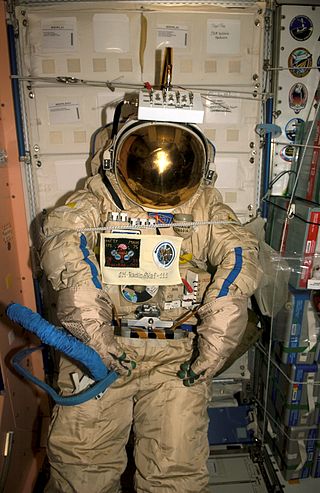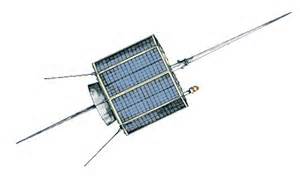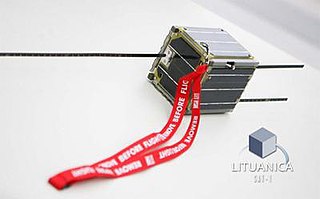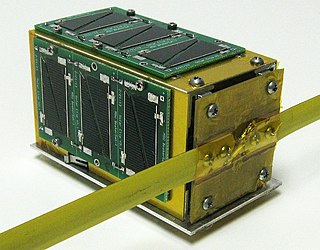South Atlantic anomaly

As it went around the Earth it encountered data upsets, geo-located around the South Atlantic anomaly.
| Operator | University of Surrey [1] |
|---|---|
| COSPAR ID | 1984-021B [2] |
| SATCAT no. | 14781 |
| Spacecraft properties | |
| Manufacturer | SSTL |
| Launch mass | 60 kilograms (130 lb) |
| Start of mission | |
| Launch date | 1 March 1984, 17:59 UTC |
| Rocket | Delta 3920 |
| Launch site | Vandenberg SLC-2W |
| Orbital parameters | |
| Reference system | Geocentric |
| Regime | Sun-synchronous |
| Inclination | 98.25 degrees |
UoSAT-2, which is also known as UO-11 and OSCAR-11, is a British satellite orbiting in Low Earth Orbit. The satellite functions as an amateur radio transmitter (known as an OSCAR) and was built at the University of Surrey. It launched into orbit in March 1984 and remains orbital and active, though unstable with irregular periods of transmission. All of the analogue telemetry channels failed in 2005, but as of 2014 the status channels were still operational. [3] The satellite was still heard transmitting telemetry in 2023, thirty-nine years after launch. [4]
It was operated by Surrey Satellite Technology Ltd.
The satellite was the second in the UoSAT series of satellites built by University of Surrey; preceded by UoSAT-1 and followed by UoSAT-3.
The satellite carries a Digitalker speech synthesiser, [5] [6] magnetometers, a CCD camera, a Geiger-Müller tube, and a microphone to detect the vibrations of micrometeoroid impacts. [6] Like UoSAT-1 it transmits telemetry data on the VHF beacon at 1200 baud, using asynchronous AFSK, [7] though now all analogue telemetry channels have failed; [8] on an FM receiver the audio signal resembles the cassette data format of the contemporary BBC Micro computer. [6] Actually it is a BASICODE signal, but no citation. Slight modulation had also been observed on the S band beacon. [9]
UoSAT-2's solar arrays were bought at a premium compared to those of UoSAT-1, the design having been space tested by its predecessor. [6]
The British affiliate of AMSAT distributed a library of software for the BBC Micro to track UoSAT-2 and other satellites and analyse telemetry broadcasts. [10] A commercial fixed-frequency receiver, Astrid, was also produced by British firm MM Microwave [11] for the education market, with accompanying BBC Micro software to display raw telemetry frames. For versatility the Astrid set included a demodulator to load signals through the serial port of any computer. [6]

As it went around the Earth it encountered data upsets, geo-located around the South Atlantic anomaly.
According to a February 2008 status report the satellite had no viable battery backup, operating only from its solar panels, and a watchdog timer on board was suspending activity for up to three weeks following any power anomaly. At the time of the report it was experiencing continuous sunlight for the last time, with the prediction that "permanent eclipses" in its orbit would begin in the middle of March 2008, limiting transmissions to "a short time, possibly less [than] a single orbit, every 21 days." [8] By April 2008 the updated prediction was that eclipses would continue until 2019. [12]
After a 21-month gap in observations, UoSAT-2 resumed sending telemetry sometime before 10 December 2009, and is apparently continuing the watchdog-controlled transmission regime, though now on a ten-days-on, ten-days-off schedule. Its condition has not otherwise improved apart from some recovery of battery power, allowing broadcasts to continue into each eclipse. [10]
Current observation reports for UoSAT-2 can be viewed and logged at the Oscar Satellite Status Page. [13]
The satellite was instrumental in providing a communications link, known as Nordski Comm, from the Ski-Trek support teams to the expedition party. The position of the skiers' emergency beacon was calculated daily by Cospas-Sarsat ground stations and relayed to them, and thousands of amateur radio listeners, as a spoken message from the Digitalker on board UoSAT-2. The message could also serve as an emergency channel to the skiers in the event that all other radio links failed. [5] [14]
AMSAT is a name for various amateur radio satellite organizations worldwide. In particular, it often refers to the Radio Amateur Satellite Corporation, headquartered in Washington, D.C. AMSAT organizations design, build, arrange launches for, and then operate (command) satellites carrying amateur radio payloads, including the OSCAR series of satellites. Other informally affiliated national organizations exist, such as AMSAT Germany (AMSAT-DL) and AMSAT Japan (JAMSAT).
AMSAT-OSCAR-40, also known as AO-40 or simply OSCAR 40, was the on-orbit designation of an amateur radio satellite of the OSCAR series. Prior to launch, the spacecraft was known as Phase 3D or "P3D". AO-40 was built by AMSAT.

AMSAT-OSCAR 51 or AO-51 is the in-orbit name designation of a now defunct LEO amateur radio satellite of the OSCAR series; formerly known as ECHO, built by AMSAT. It was launched on June 29, 2004 from Baikonur Cosmodrome, Kazakhstan on a Dnepr launch vehicle. It is in Sun synchronous low Earth orbit.
HAMSAT also known as HAMSAT INDIA, VU2SAT and VO-52 is a microsatellite weighing 42.5 kilograms (93.7 lb), providing amateur radio satellite communications services for Indian and international amateur radio operators. This satellite carries the in-orbit designation of VO-52, and is an OSCAR series satellite.

SuitSat was a retired Russian Orlan space suit with a radio transmitter mounted on its helmet, used as a hand-launched satellite.
CUTE-1.7 + APD or CO-56 (Cubesat-Oscar-56) or just OSCAR 56 was an amateur radio satellite in the form of a double CubeSat. The satellite used commercial off-the-shelf components extensively, in particular, it used the Hitachi NPD-20JWL PDA as a control computer, and it used a USB hub for sensor communications. At the end of its mission, the satellite was supposed to deploy an electrodynamic tether to help it deorbit. The satellite failed early into its mission, so the electrodynamic tether experiment probably did not happen. It was launched on February 21, 2006 on board a Japanese launcher M-V.
SumbandilaSat, was a South African micro Earth observation satellite, launched on 17 September 2009 on a Soyuz-2 launch vehicle from the Baikonur Cosmodrome. The first part of the name, Sumbandila, is from the Venda language and means "lead the way".
UoSAT-1, also known as UoSAT-OSCAR 9 (UO-9), was a British amateur radio satellite which orbited Earth. It was built at the University of Surrey and launched into low Earth orbit on 6 October 1981. It exceeded its anticipated two-year orbital lifespan by six years, having received signals on 13 October 1989, before re-entering the atmosphere.

AMSAT-OSCAR 7, or AO-7, is the second Phase 2 amateur radio satellite constructed by the Radio Amateur Satellite Corporation (AMSAT). It was launched into Low Earth Orbit on November 15, 1974 and remained operational until a battery failure in 1981. After 21 years of apparent silence, the satellite was heard again on June 21, 2002 – 27 years after launch. At that time the public learned that the satellite had remained intermittently functional and was used surreptitiously for communication by the anticommunist opposition Fighting Solidarity during martial law in Poland.
SSETI Express was the first spacecraft to be designed and built by European students and was launched by the European Space Agency. SSETI Express is a small spacecraft, similar in size and shape to a washing machine. On board the student-built spacecraft were three CubeSat picosatellites, extremely small satellites weighing around one kg each. These were deployed one hour and forty minutes after launch. Twenty-one university groups, working from locations spread across Europe and with very different cultural backgrounds, worked together via the internet to jointly create the satellite. The expected lifetime of the mission was planned to be 2 months. SSETI Express encountered an unusually fast mission development: less than 18 months from kick-off in January 2004 to flight-readiness.
AMSAT-OSCAR 16, also known as AO-16 and PACSAT, is the in-orbit name designation of an amateur radio satellite of the OSCAR series. It was built by AMSAT and was launched on 22 January 1990 from Kourou, French Guiana on an Ariane 4 launch vehicle. It is in Sun synchronous low Earth orbit.
An amateur radio satellite is an artificial satellite built and used by amateur radio operators. It forms part of the Amateur-satellite service. These satellites use amateur radio frequency allocations to facilitate communication between amateur radio stations.

The Soviet–Canadian 1988 Polar Bridge Expedition began on March 3, 1988, when a group of thirteen Russian and Canadian skiers set out from Siberia, in an attempt to ski to Canada over the North Pole. The nine Russians and four Canadians reached the pole on 25 April and concluded their trek on Wednesday, June 1, 1988, when they reached Ward Hunt Island, Ellesmere, Northern Canada. At the North Pole, they were welcomed by a group of dignitaries from the Soviet Union and Canada, members of the international press, and radio amateurs involved in support and communications.

OSCAR 3 is the third amateur radio satellite launched by Project OSCAR into Low Earth Orbit. OSCAR 3 was launched March 9, 1965 by a Thor-DM21 Agena D launcher from Vandenberg Air Force Base, Lompoc, California. The satellite, massing 15 kg (33 lb), was launched piggyback with seven United States Air Force satellites. Though the satellite's active life was limited to sixteen days due to battery failure, OSCAR 3 relayed 176 messages from 98 stations in North America and Europe during its 274 orbit life-time -- the first amateur satellite to relay signals from Earth. As of 2023, it is still in orbit.

LituanicaSAT-1 was one of the first two Lithuanian satellites. It was launched along with the second Cygnus spacecraft and 28 Flock-1 CubeSats aboard an Antares 120 carrier rocket flying from Pad 0B at the Mid-Atlantic Regional Spaceport on Wallops Island to the International Space Station. The launch was scheduled to occur in December 2013, but later was rescheduled to 9 January 2014 and occurred then. The satellite was broadcasting greetings of Lithuanian president, Mrs. Dalia Grybauskaitė. The satellite was deployed from the International Space Station via the NanoRacks CubeSat Deployer on February 28, 2014. All LituanicaSAT-1 subsystems have been turned on, tested and proved to be working properly. The mission is considered a complete success by its team of engineers. The mission ended upon the reentry and disintegration of the satellite on July 28, 2014.

Dove-OSCAR 17 is a Brazilian educational and amateur radio satellite (BRAMSAT) (AMSAT-BRAZIL) launched on 22 January 1990.

Es'hail 2 is a Qatari satellite, launched aboard a SpaceX Falcon 9 rocket on November 15, 2018. Es'hail 2 was built by Japan's Mitsubishi Electric company, and operates at 26° East longitude along a geostationary orbit to provide direct-to-home television services in the Middle East and North Africa region. The satellite features 24 Ku-band and 11 Ka-band transponders to provide direct broadcasting services for television, government and commercial content distribution. In addition to commercial services, the payload of Es'hail 2 includes a linear transponder with a bandwidth of 500 kHz and 8 MHz for the amateur radio satellite service, with uplink on 2.4 GHz and downlink on 10.45 GHz.
Fox-1A, AO-85 or AMSAT OSCAR 85 is an American amateur radio satellite. It is a 1U Cubesat, was built by the AMSAT-NA and carries a single-channel transponder for FM radio. The satellite has one rod antenna each for the 70 centimetres (28 in) and 2 metres bands. To enable a satellite launch under NASA's Educational Launch of Nanosatellites (ELaNa) program, the satellite continues to carry a Penn State University student experiment.

$50SAT is an American amateur radio communications satellite. It was launched on November 21, 2013, with a Dnepr launch vehicle from the Dombarovsky Air Base, in Orenburg, Russia. It was part of the UNISAT-5 satellite program by GAUSS.
Fox-1E, AO-109 or AMSAT OSCAR 109 is an American amateur radio satellite. It is a 1U Cubesat, was built by the AMSAT-NA and carries a 30KHz linear transponder radio. Fox-1E is the fifth amateur radio satellite of the Fox series of AMSAT North America.
{{cite web}}: CS1 maint: unfit URL (link)